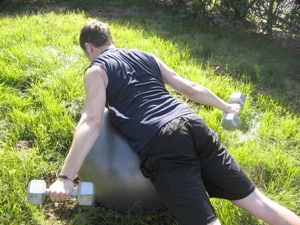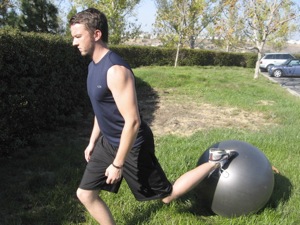health & sports
Fit for Life
On the ball: The great stability ball combines fitness and fun
Published Thursday, 15-Nov-2007 in issue 1038
The stability ball (a.k.a. Swiss ball) has quickly become one of the most popular pieces of exercise equipment. Originally used in physical therapy settings, the stability ball has become as widespread as treadmills with every gym, Pilates studio and private training facility housing at least a few. And with all this increased availability and fanfare, scientists have shifted focus to study its many benefits and to determine if it’s really as great as all its proponents have suggested. What scientists have discovered is that this amazingly simple tool really is all it’s believed to be … and more.
One such report suggested promising evidence for its assistance in increasing overall muscular activation, with an emphasis on the core. Its relative instability requires all the tiny little intraspinal muscles to continuously correct in order for the user to remain on top of it. The ball also requires prime movers (those muscles responsible for action, such as the biceps in the biceps curl) to work harder as the body must be kept absolutely still in order to maintain stability. For instance, if you are prone to swaying your body to complete a movement, the stability ball lets you know immediately that your form has faltered. Following is a sample full-body workout that is sure to test your abilities.
The crunch
For those of you still lying on the ground to perform crunches, it’s time to think outside the mat and get on the ball. While doing the crunch on the ground has its benefits, trading up for the stability ball will add variety to your routine and, according to several emerging research studies, actually increases abdominal muscular activity. Those new to this exercise or piece of equipment should place the ball up near the shoulder blades. If you’ve already got A-plus abs and want to intensify your workout, place the ball further down the spine and allow your upper back to wrap around it before beginning the exercise. You might also add external resistance by holding onto a medicine ball or dumbbell.
Seated overhead press
Trading the bench for the stability ball helps teach your shoulders greater control while making them stronger and more defined. Find a relatively light weight (once you get the hang of it, you’ll be lifting more weight in no time), take a seat on the ball and press the weights above your head. Make sure that your abdominals are contracted throughout the movement to prevent excess lower back arch.
Reverse flyes
Place the ball so that it is just underneath the chest. Allow the upper body to wrap around the ball, then grab your weights, pull your shoulder blades together and lift your chest away from the ball so that you make a straight line from the back of your head to your heels. Hold for a few seconds and repeat. You’ll want to actively contract your glutes and leg muscles for greater stability.
Lunge
The lunge and squat are considered the gold standard for developing lower body strength. They can also help you fill out those Ginches. Get into a staggered stance lunge position and place the rear foot on top of the ball. This can be a bit tricky at first, so be patient. Once you’re in position, lean slightly forward so most of your weight is centered over the front leg. Slowly lower the body toward the ground until the upper leg becomes parallel with the floor. Return to the start position and repeat. When you’re able to perform the movement without wobbling, grab some dumbbells for extra resistance.
Chest press
The chest press is a workout staple. Oftentimes, though, the popularity of this exercise can become a nuisance to enthusiasts who have difficulty claiming an open bench. Instead of wasting precious workout time waiting for your turn, grab one of the many unused stability balls and use it as your bench. You might be surprised just how challenging this exercise becomes. Place your head and shoulders comfortably on the ball and lift your hips up toward the ceiling. Slowly press the weights above the chest and return to start.
The stability ball is a great addition to any workout, however it is very important to take things slowly and lightly at first. Avoid jerky movements and focus on the task at hand. Feel what’s happening with your body, and if you feel any pain, stop immediately. Most importantly, have fun!
|
|
Copyright © 2003-2025 Uptown Publications






